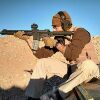JDinFbg
Member
I just received and used the first dot sight I've ever owned on my Winchester '94 (my old eyes and iron sight are no longer compatible). The dot sight is a Burris FastFire 2 reflex sight with a 4 MOA dot. It is mounted on a no-drill picatinny rail and sits low enough to maintain a good cheek weld during shooting. My only experience with dot sights before now was doing some limited shooting with a friend's AR with a 2 MOA dot sight. I found the 2 MOA dot hard to see and acquire under bright daylight conditions. I wanted something usable under all light conditions for shooting feral hogs at ranges of 25-100 yards, so was only looking for minute-of-pig resolution.
I decided to mount the sight as far back on the rail as possible in order to maintain the maximum field of view through the sight lens. However, on my first shooting outing to zero in the sight, I noted the 4 MOA dot totally covered an 8" diameter target at 100 yards. My thought is that a 4 MOA dot should cover a 4" circle at 100 yards. So, now I'm wondering what dot size really means in a dot sight? Are dot sizes specified based on the sight being positioned some certain distance from the shooter's eye?. I'm wondering if moving the sight forward on the rail will result in the dot appearing smaller and closer to the specified 4 MOA size? The rail will allow me to move the sight about 5-6" farther forward.
I decided to mount the sight as far back on the rail as possible in order to maintain the maximum field of view through the sight lens. However, on my first shooting outing to zero in the sight, I noted the 4 MOA dot totally covered an 8" diameter target at 100 yards. My thought is that a 4 MOA dot should cover a 4" circle at 100 yards. So, now I'm wondering what dot size really means in a dot sight? Are dot sizes specified based on the sight being positioned some certain distance from the shooter's eye?. I'm wondering if moving the sight forward on the rail will result in the dot appearing smaller and closer to the specified 4 MOA size? The rail will allow me to move the sight about 5-6" farther forward.



